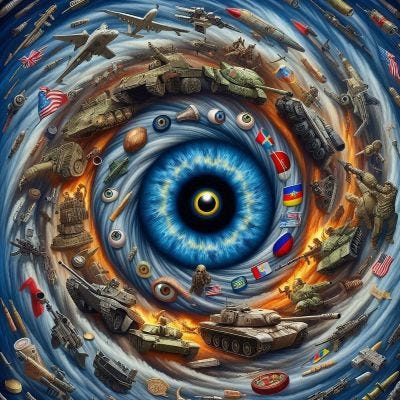By Tetyana Malyarenko & Stefan Wolff
On March 11, 2025, senior US and Ukrainian officials reached an agreement on an American proposal for a thirty-day ceasefire in the war in Ukraine after nine hours of negotiations behind closed doors in Jeddah, Saudi Arabia.
This does not mean that the guns in the war will now immediately fall silent. No ceasefire agreement between the warring parties — Russia and Ukraine — has been signed. In fact, it is not even clear how much detail is contained in the US ceasefire proposal and how much of it has already been discussed with Russia during earlier talks between senior US and Russian officials.
Nonetheless, the deal signals a major step forward.
From a Ukrainian perspective, it has several advantages. First, the major rift between Kyiv and Washington has at least been partially patched up. The minerals agreement — on hold since the shouting match between US president Donald Trump and his Ukrainian counterpart, Volodymyr Zelenskyy, in the White House on February 28 — is back on, with Trump extending an invitation to Zelenskyy to return to Washington to sign it.
Equally importantly for Kyiv, the resumption of US weapons deliveries to Ukraine and the lifting of the ban on intelligence sharing were part of the deal, and with immediate effect. This restores critical US battlefield support for Ukraine, including for Kyiv’s capability to strike targets deep inside Russia.
Vladimir Putin … has to balance his war aims in Ukraine with the strategically arguably more important goal of rapprochement with the United States.
By contrast, the Russian president, Vladimir Putin, is now in a somewhat trickier position. He has to balance his war aims in Ukraine with the strategically arguably more important goal of rapprochement with the United States.
Talks between senior US and Russian officials on February 18, in the Saudi capital Riyadh, seemed to indicate that Moscow had won significant concessions from Washington, including on retaining illegally occupied territory and no NATO membership for Ukraine.
These concessions may still be on the table, alongside other US offers to normalise relations and end Russia's isolation from the west. But this does not mean that Russia will be in any particular hurry to bring the fighting in Ukraine to an end. The country's economy has weathered western sanctions remarkably well so far. Putin is likely also keen on capitalising further on the momentum that his troops still have on the frontlines inside Ukraine. And he is unlikely to want to sit down to talk about a ceasefire, let alone a peace agreement, with Zelensky as long as Ukraine still holds territory in the Kursk region inside Russia. While Ukrainian troops have come under increasing pressure there recently and are in danger of being encircled, it is likely to take Russia some more time to force them to withdraw completely or to surrender.
Putin is thus likely to play for more time in an effort to push his advantage on the ground while avoiding upsetting Trump.
Putin is thus likely to play for more time in an effort to push his advantage on the ground while avoiding upsetting Trump. The deputy head of the upper house of the Russian parliament, the Federation Council, and chairman of its international affairs committee, Konstantin Kosachev, signalled as much after the US-Ukraine deal had been announced. He insisted that any agreements would have to be on Russian, rather than American, let alone Ukrainian, terms.
The Kremlin’s immediate reaction also lacked enthusiasm. Putin’s spokesman, Dmitry Peskov, noted that Moscow was still awaiting detailed information on what Kyiv and Washington had agreed. Both of these initial responses indicate a willingness to talk, but they also signal that an agreement, even on a ceasefire, will very likely still require further negotiations.
Playing for time will also allow Putin to avoid rebuffing the American proposal outright. To do so would be a huge gamble for the Russian president. Trump has already proven his willingness to exert maximum pressure on Ukraine — and he seems to have got his way. Ahead of the US-Ukraine meeting in Jeddah, he was also clear that he would consider further sanctions on Russia to force Moscow to accept an end to the fighting in Ukraine.
Both of these steps — pressure on Ukraine and on Russia — are part of a plan developed by Trump’s special Ukraine envoy Keith Kellogg back in May 2024. Crucially, Kellogg also envisaged continuing “to arm Ukraine and strengthen its defences to ensure Russia will make no further advances and will not attack again after a ceasefire or peace agreement”.
If Putin were to reject the current proposal, he would therefore not only risk a broader reset of US-Russia relations but potentially also lose his current battlefield advantage, as well as territory Moscow currently controls because a boost to Ukrainian military capabilities would likely shift the military balance of power, at least on some parts of the frontline.
The Kremlin is likely to engage with the White House on the American ceasefire proposal that has now been accepted by Ukraine while pushing hard for further territorial gains before US-Russia talks conclude.
The most likely scenario going forward is a two-pronged Russian approach. The Kremlin is likely to engage with the White House on the American ceasefire proposal that has now been accepted by Ukraine while pushing hard for further territorial gains before US-Russia talks conclude. The peculiar set-up of the negotiations also plays into the Kremlin's hands here. Short of direct talks between Kyiv and Moscow, Washington has to shuttle between them, trying to close gaps between their positions with a mixture of diplomacy and pressure. This has worked reasonably well with Ukraine so far, but it is far less certain that this approach will bear similar fruit with Russia.
The temporary ceasefire currently on the table may, or may not, be an important step towards a permanent cessation of violence and a sustainable peace agreement. Whether it will become a milestone on the path to peace will depend on President Trump's willingness to pressure Russia in a similar way to Ukraine.
Lest we forget, Ukraine has already paid a huge price as a result of Russia's aggression. Any further delay on the path to a just peace will inflict yet more pain on the victim instead of the aggressor.
An earlier version of this analysis was published by The Conversation on March 12, 2025.
We hope you'll share Navigating the Vortex with anyone you think might find it of interest. Also, you can listen to our podcast editions via the website and on all major podcast platforms, including:












